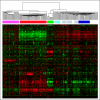Supervised risk predictor of breast cancer based on intrinsic subtypes
- PMID: 19204204
- PMCID: PMC2667820
- DOI: 10.1200/JCO.2008.18.1370
Supervised risk predictor of breast cancer based on intrinsic subtypes
Abstract
PURPOSE To improve on current standards for breast cancer prognosis and prediction of chemotherapy benefit by developing a risk model that incorporates the gene expression-based "intrinsic" subtypes luminal A, luminal B, HER2-enriched, and basal-like. METHODS A 50-gene subtype predictor was developed using microarray and quantitative reverse transcriptase polymerase chain reaction data from 189 prototype samples. Test sets from 761 patients (no systemic therapy) were evaluated for prognosis, and 133 patients were evaluated for prediction of pathologic complete response (pCR) to a taxane and anthracycline regimen.
Results: The intrinsic subtypes as discrete entities showed prognostic significance (P = 2.26E-12) and remained significant in multivariable analyses that incorporated standard parameters (estrogen receptor status, histologic grade, tumor size, and node status). A prognostic model for node-negative breast cancer was built using intrinsic subtype and clinical information. The C-index estimate for the combined model (subtype and tumor size) was a significant improvement on either the clinicopathologic model or subtype model alone. The intrinsic subtype model predicted neoadjuvant chemotherapy efficacy with a negative predictive value for pCR of 97%. CONCLUSION Diagnosis by intrinsic subtype adds significant prognostic and predictive information to standard parameters for patients with breast cancer. The prognostic properties of the continuous risk score will be of value for the management of node-negative breast cancers. The subtypes and risk score can also be used to assess the likelihood of efficacy from neoadjuvant chemotherapy.
Conflict of interest statement
Authors' disclosures of potential conflicts of interest and author contributions are found at the end of this article.
Figures









Republished in
-
Supervised Risk Predictor of Breast Cancer Based on Intrinsic Subtypes.J Clin Oncol. 2023 Sep 10;41(26):4192-4199. doi: 10.1200/JCO.22.02511. J Clin Oncol. 2023. PMID: 37672882
Comment in
-
Introducing molecular subtyping of breast cancer into the clinic?J Clin Oncol. 2009 Mar 10;27(8):1153-4. doi: 10.1200/JCO.2008.20.6276. Epub 2009 Feb 9. J Clin Oncol. 2009. PMID: 19204193 No abstract available.
References
-
- van 't Veer LJ, Dai H, van de Vijver MJ, et al. Gene expression profiling predicts clinical outcome of breast cancer. Nature. 2002;415:530–536. - PubMed
-
- van't Veer LJ, Paik S, Hayes DF. Gene expression profiling of breast cancer: A new tumor marker. J Clin Oncol. 2005;23:1631–1635. - PubMed
-
- Paik S, Shak S, Tang G, et al. A multigene assay to predict recurrence of tamoxifen-treated, node-negative breast cancer. N Engl J Med. 2004;351:2817–2826. - PubMed
-
- Paik S, Tang G, Shak S, et al. Gene expression and benefit of chemotherapy in women with node-negative, estrogen receptor-positive breast cancer. J Clin Oncol. 2006;24:3726–3734. - PubMed
Publication types
MeSH terms
Substances
Grants and funding
LinkOut - more resources
Full Text Sources
Other Literature Sources
Medical
Molecular Biology Databases
Research Materials
Miscellaneous

